Page 700 of 1574
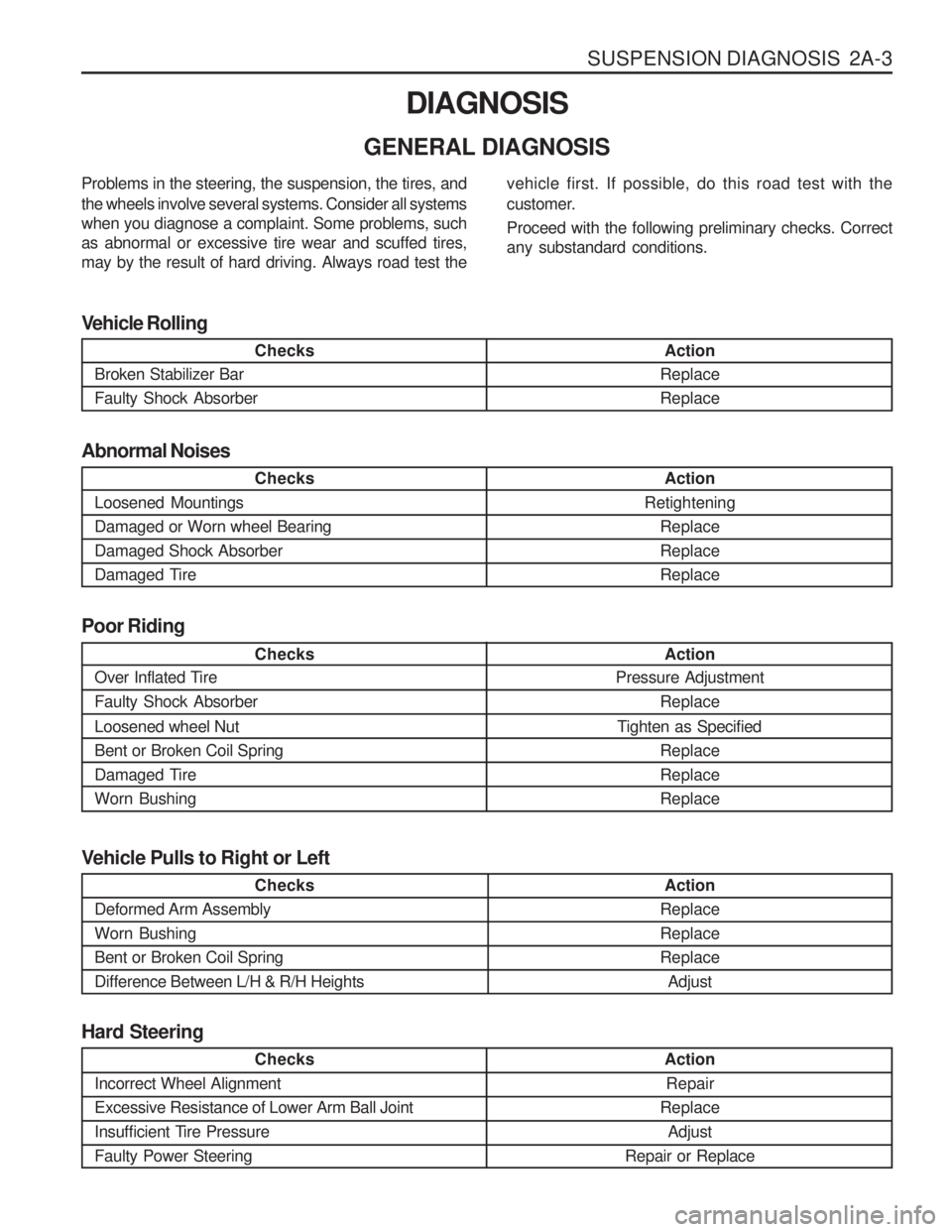
SUSPENSION DIAGNOSIS 2A-3
DIAGNOSIS
GENERAL DIAGNOSIS
Checks
Loosened Mountings Damaged or Worn wheel BearingDamaged Shock Absorber
Damaged Tire Action
Retightening ReplaceReplaceReplace
Abnormal Noises
Checks
Broken Stabilizer Bar Faulty Shock Absorber Action
ReplaceReplace
Vehicle Rolling
Checks
Over Inflated Tire Faulty Shock Absorber Loosened wheel Nut Bent or Broken Coil Spring
Damaged TireWorn Bushing Action
Pressure Adjustment
Replace
Tighten as Specified ReplaceReplaceReplace
Poor Riding
Problems in the steering, the suspension, the tires, and the wheels involve several systems. Consider all systems when you diagnose a complaint. Some problems, suchas abnormal or excessive tire wear and scuffed tires,may by the result of hard driving. Always road test the
vehicle first. If possible, do this road test with the
customer. Proceed with the following preliminary checks. Correct any substandard conditions.
Checks
Incorrect Wheel Alignment Excessive Resistance of Lower Arm Ball Joint
Insufficient Tire PressureFaulty Power Steering
Action Repair
Replace Adjust
Repair or Replace
Hard Steering
Checks
Deformed Arm Assembly Worn BushingBent or Broken Coil SpringDifference Between L/H & R/H Heights Action
ReplaceReplaceReplace Adjust
Vehicle Pulls to Right or Left
Page 701 of 1574
2A-4 SUSPENSION DIAGNOSISChecks
Worn or Broken Coil Spring Checks
Incorrect Front wheel Alignment Worn or Loosened Lower Arm Bushing
Action
Replace
Repair or Replace
Steering Instability
Action
Replace
Vehicle Bottoming
Page 711 of 1574
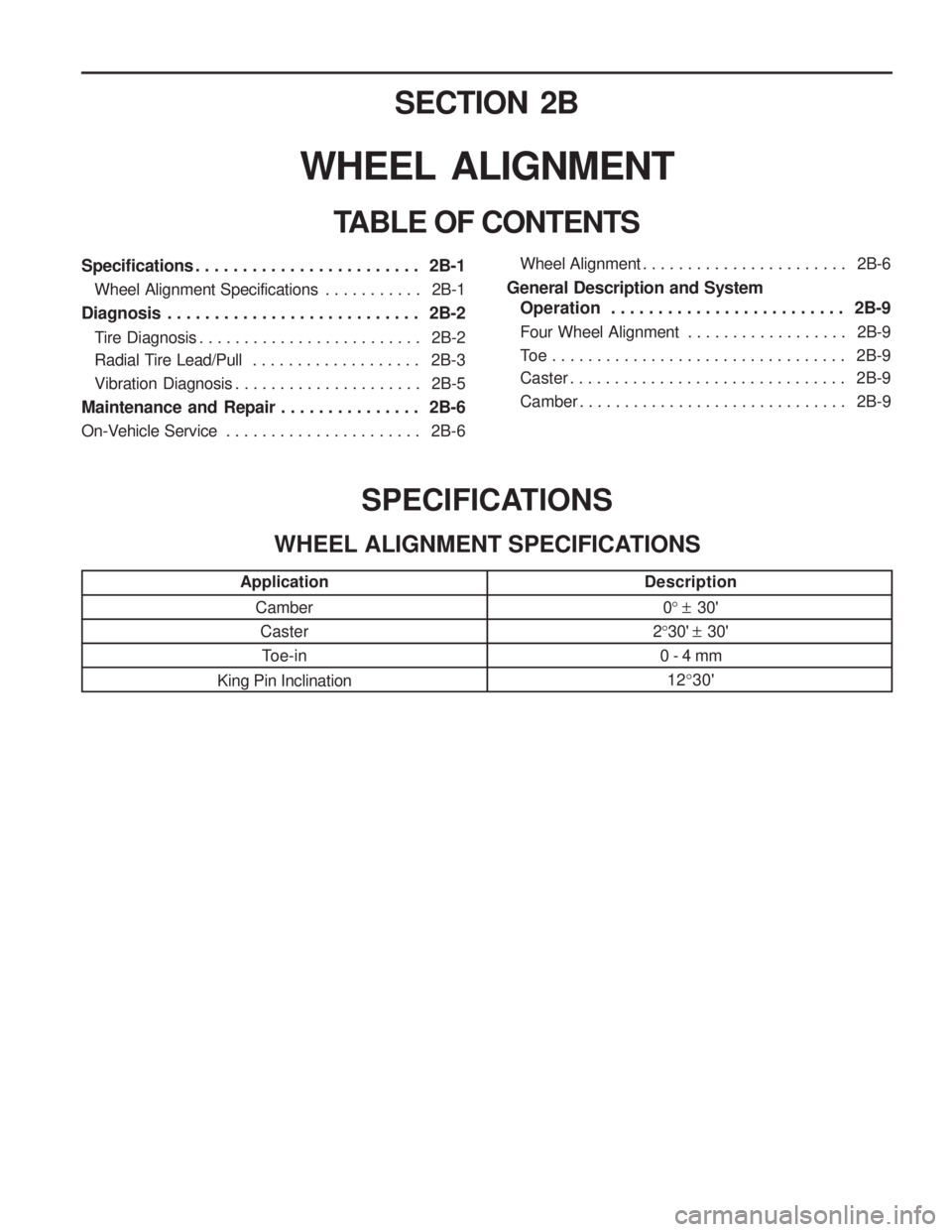
SECTION 2B
WHEEL ALIGNMENT
TABLE OF CONTENTSSPECIFICATIONS
WHEEL ALIGNMENT SPECIFICATIONS
Application CamberCaster
Toe-in
King Pin Inclination Description
0° ± 30'
2 °30' ± 30'
0 - 4 mm 12 °30'
Specifications . . . . . . . . . . . . . . . . . . . . . . . . 2B-1
Wheel Alignment Specifications . . . . . . . . . . . 2B-1
Diagnosis . . . . . . . . . . . . . . . . . . . . . . . . . . . 2B-2 Tire Diagnosis . . . . . . . . . . . . . . . . . . . . . . . . . 2B-2
Radial Tire Lead/Pull . . . . . . . . . . . . . . . . . . . 2B-3
Vibration Diagnosis . . . . . . . . . . . . . . . . . . . . . 2B-5
Maintenance and Repair . . . . . . . . . . . . . . . 2B-6
On-Vehicle Service . . . . . . . . . . . . . . . . . . . . . . 2B-6Wheel Alignment . . . . . . . . . . . . . . . . . . . . . . . 2B-6
General Description and System Operation . . . . . . . . . . . . . . . . . . . . . . . . . 2B-9
Four Wheel Alignment . . . . . . . . . . . . . . . . . . 2B-9
Toe . . . . . . . . . . . . . . . . . . . . . . . . . . . . . . . . . 2B-9
Caster . . . . . . . . . . . . . . . . . . . . . . . . . . . . . . . 2B-9
Camber . . . . . . . . . . . . . . . . . . . . . . . . . . . . . . 2B-9
Page 712 of 1574
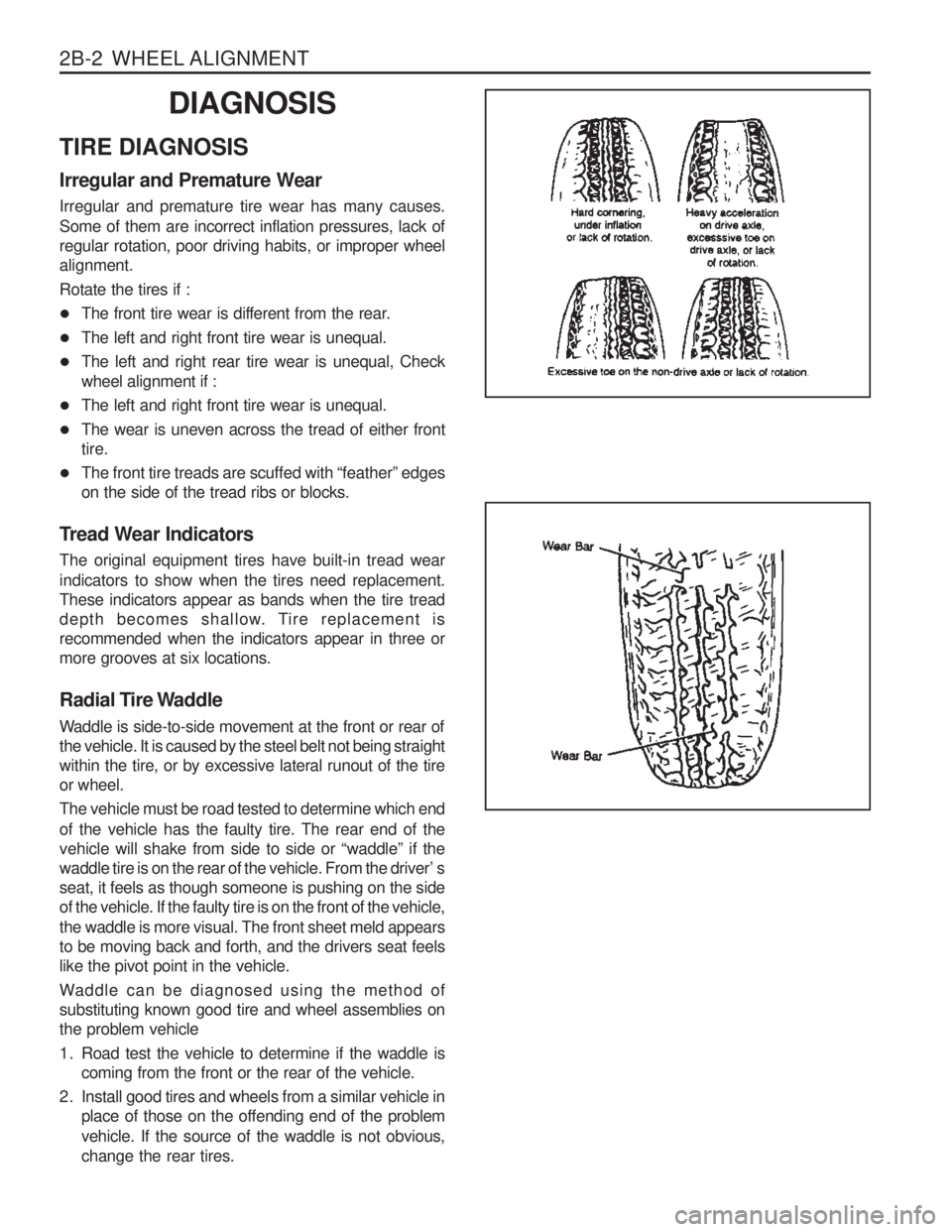
2B-2 WHEEL ALIGNMENT
DIAGNOSIS
TIRE DIAGNOSIS Irregular and Premature Wear Irregular and premature tire wear has many causes. Some of them are incorrect inflation pressures, lack of regular rotation, poor driving habits, or improper wheelalignment. Rotate the tires if :
� The front tire wear is different from the rear.
� The left and right front tire wear is unequal.
� The left and right rear tire wear is unequal, Check wheel alignment if :
� The left and right front tire wear is unequal.
� The wear is uneven across the tread of either fronttire.
� The front tire treads are scuffed with “feather” edgeson the side of the tread ribs or blocks.
Tread Wear Indicators The original equipment tires have built-in tread wear indicators to show when the tires need replacement. These indicators appear as bands when the tire tread
depth becomes shallow. Tire replacement isrecommended when the indicators appear in three ormore grooves at six locations.
Radial Tire Waddle
Waddle is side-to-side movement at the front or rear of the vehicle. It is caused by the steel belt not being straightwithin the tire, or by excessive lateral runout of the tireor wheel. The vehicle must be road tested to determine which end of the vehicle has the faulty tire. The rear end of the vehicle will shake from side to side or “waddle” if the
waddle tire is on the rear of the vehicle. From the driver’ sseat, it feels as though someone is pushing on the sideof the vehicle. If the faulty tire is on the front of the vehicle, the waddle is more visual. The front sheet meld appears to be moving back and forth, and the drivers seat feelslike the pivot point in the vehicle.
Waddle can be diagnosed using the method of substituting known good tire and wheel assemblies onthe problem vehicle
1. Road test the vehicle to determine if the waddle is coming from the front or the rear of the vehicle.
2. Install good tires and wheels from a similar vehicle in place of those on the offending end of the problem vehicle. If the source of the waddle is not obvious, change the rear tires.
Page 713 of 1574
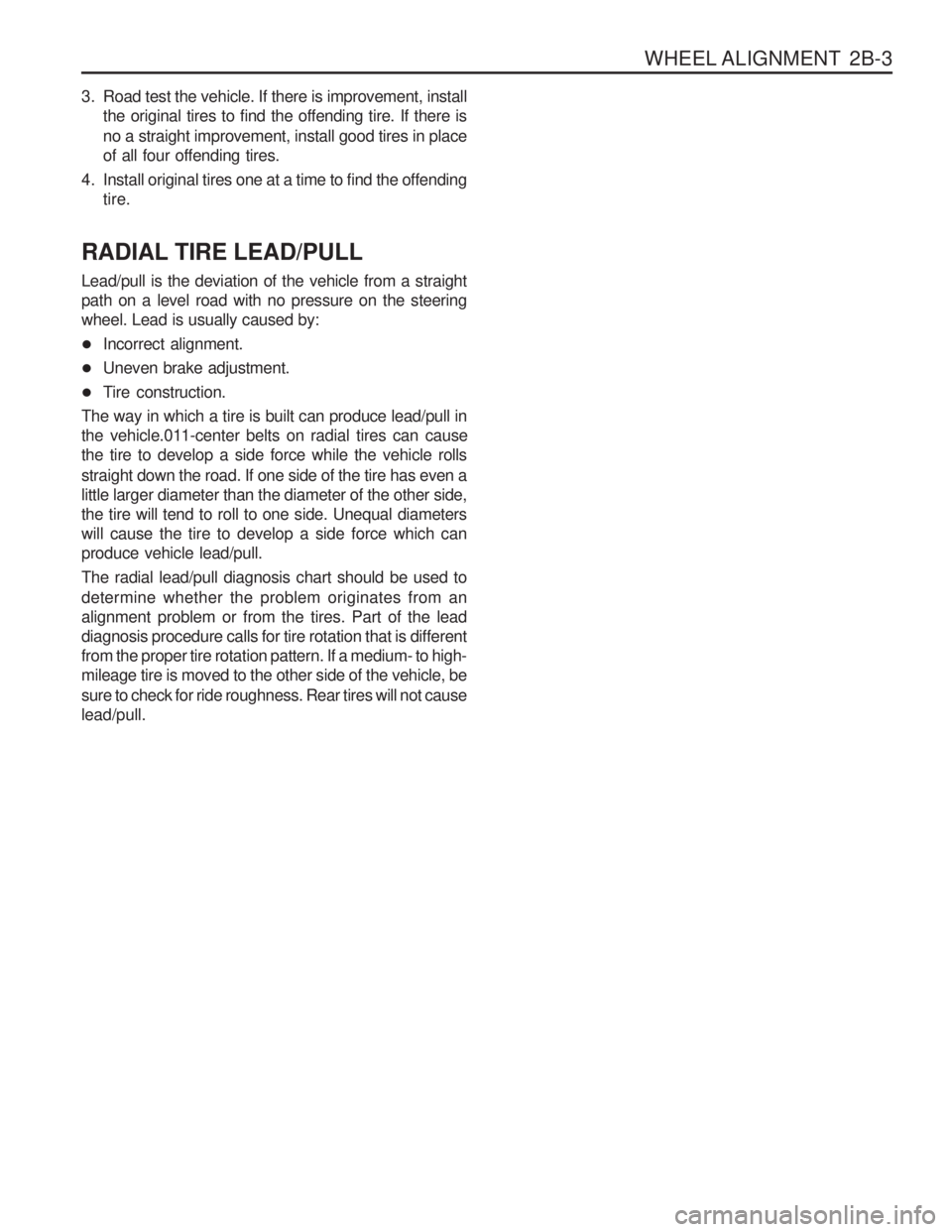
WHEEL ALIGNMENT 2B-3
3. Road test the vehicle. If there is improvement, installthe original tires to find the offending tire. If there is no a straight improvement, install good tires in place of all four offending tires.
4. Install original tires one at a time to find the offending tire.
RADIAL TIRE LEAD/PULL Lead/pull is the deviation of the vehicle from a straight path on a level road with no pressure on the steeringwheel. Lead is usually caused by:
� Incorrect alignment.
� Uneven brake adjustment.
� Tire construction.
The way in which a tire is built can produce lead/pull in
the vehicle.011-center belts on radial tires can causethe tire to develop a side force while the vehicle rolls straight down the road. If one side of the tire has even a little larger diameter than the diameter of the other side,the tire will tend to roll to one side. Unequal diameterswill cause the tire to develop a side force which canproduce vehicle lead/pull. The radial lead/pull diagnosis chart should be used to determine whether the problem originates from an alignment problem or from the tires. Part of the leaddiagnosis procedure calls for tire rotation that is differentfrom the proper tire rotation pattern. If a medium- to high-mileage tire is moved to the other side of the vehicle, be sure to check for ride roughness. Rear tires will not cause lead/pull.
Page 714 of 1574
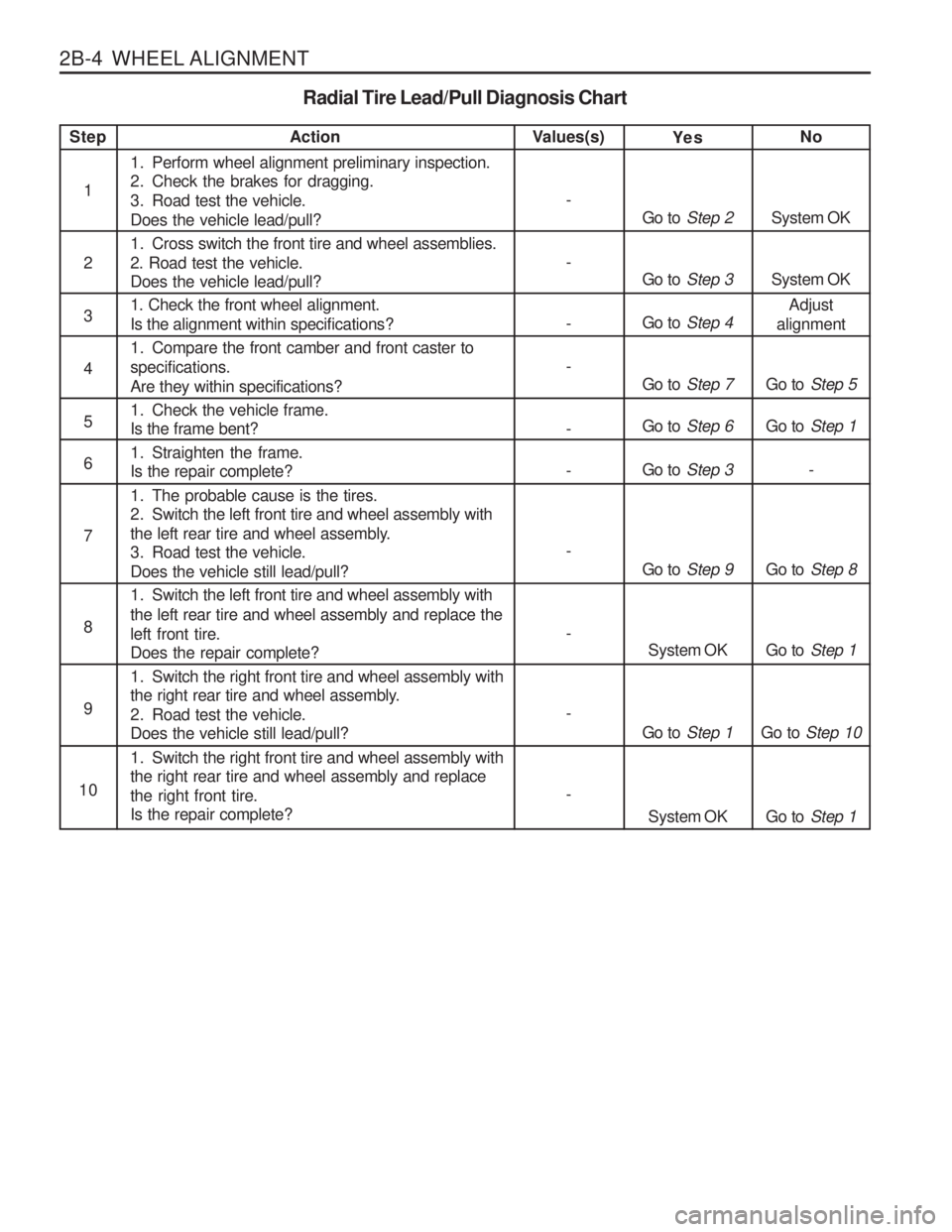
2B-4 WHEEL ALIGNMENT1. Perform wheel alignment preliminary inspection.
2. Check the brakes for dragging.
3. Road test the vehicle.Does the vehicle lead/pull?
1. Cross switch the front tire and wheel assemblies. 2. Road test the vehicle. Does the vehicle lead/pull? 1. Check the front wheel alignment. Is the alignment within specifications?
1. Compare the front camber and front caster to specifications.Are they within specifications?
1. Check the vehicle frame. Is the frame bent?
1. Straighten the frame. Is the repair complete?
1. The probable cause is the tires.
2. Switch the left front tire and wheel assembly with
the left rear tire and wheel assembly.
3. Road test the vehicle. Does the vehicle still lead/pull?
1. Switch the left front tire and wheel assembly with the left rear tire and wheel assembly and replace theleft front tire. Does the repair complete?
1. Switch the right front tire and wheel assembly with
the right rear tire and wheel assembly.
2. Road test the vehicle. Does the vehicle still lead/pull?
1. Switch the right front tire and wheel assembly with the right rear tire and wheel assembly and replace the right front tire. Is the repair complete? Action
Radial Tire Lead/Pull Diagnosis Chart
Step
1Values(s)
- Ye s
Go to Step 2
Go to Step 3
Go to Step 4
Go to Step 7
Go to Step 6
Go to Step 3
Go to Step 9
System OK
Go to Step 1
System OK No
System OK System OK Adjust
alignment
Go to Step 5
Go to Step 1
-
Go to Step 8
Go to Step 1
Go to Step 10
Go to Step 1
2 345 6 7 8 9
10 - - - - - - - - -
Page 715 of 1574

WHEEL ALIGNMENT 2B-5
VIBRATION DIAGNOSIS Wheel imbalance causes most highway speed vibration problems. A vibration can remain after dynamicbalancing because:
�A tire is out of round.
� A rim is out of round.
� A tire stiffness variation exists.
Measuring tire and wheel free runout will uncover only part of the problem, All three causes, known as loadedradial runout, must be checked using method of substituting known good tire and wheel assemblies on the problem vehicle. Preliminary Checks Prior to performing any work, always road test the car and perform a careful visual inspection for:
�
Obvious tire and wheel runout.
� Obvious drive axle runout.
� Improper tire inflation.
� Incorrect trim height.
� Bent or damaged wheels.
� Debris build-up on the tire or the wheel.
� Irregular or excessive tire wear.
� Improper tire bead seating on the rim,
� Imperfections in the tires, including: tread deformations, separations, or bulges from impactdamage. Slight sidewall indentations are normal and
will not affect ride quality.
Tire Balancing Balance is the easiest procedure to perform and should be done first if the vibration occurs at high speeds. Do an off-vehicle, two-plane dynamic balance first to correct
any imbalance in the tire and wheel assembly. An on-vehicle finish balance will correct any brake drum,
rotor, or wheel cover imbalance, If balancing does not correct the high-speed vibration, or if the vibration occurs at low speeds, runout is the probable cause.
Page 716 of 1574
2B-6 WHEEL ALIGNMENT
MAINTENANCE AND REPAIR ON VEHICLE SERVICE WHEEL ALIGNMENT
Vehicle Height
1. Check the tire for proper inflation.
2. Measure ‘A’ from the center of the lower arm rear mounting
bolt end to the ground.
3. Measure ‘B’ from the center of the steering knuckle shaft to the ground.
4 . If the dif ference between ‘A’ and ‘B’ is not within specification,
adjust vehicle height using torsion bar height control bolt.
‘B’ - ‘A’
Notice Before wheel alignment, adjust vehicle height first.31 - 36mm
Toe-in
1. Measure toe-in.
Specification0 - 4mm
2. If toe-in is not within specification, loosen the tie rod nuts and adjust it by turning the tie rod.